Prague is the capital and largest city of the Czech Republic, and the historical capital of Bohemia. On the Vltava river, Prague is home to about 1.3 million people. The city has a temperate oceanic climate, with relatively warm summers and chilly winters.
Prague is a political, cultural, and economic hub of central Europe, with a rich history and Romanesque, Gothic, Renaissance and Baroque architectures. It was the capital of the Kingdom of Bohemia and residence of several Holy Roman Emperors, most notably Charles IV (r. 1346–1378).
It was an important city to the Habsburg monarchy and Austro-Hungarian Empire. The city played major roles in the Bohemian and the Protestant Reformations, the Thirty Years’ War and in 20th-century history as the capital of Czechoslovakia between the World Wars and the post-war Communist era.
Prague is home to a number of well-known cultural attractions, many of which survived the violence and destruction of 20th-century Europe. Main attractions include Prague Castle, Charles Bridge, Old Town Square with the Prague astronomical clock, the Jewish Quarter, Petřín hill and Vyšehrad. Since 1992, the historic center of Prague has been included in the UNESCO list of World Heritage Sites.
The city has more than ten major museums, along with numerous theaters, galleries, cinemas, and other historical exhibits. An extensive modern public transportation system connects the city. It is home to a wide range of public and private schools, including Charles University in Prague, the oldest university in Central Europe.
1.Walk the Grounds of Prague Castle
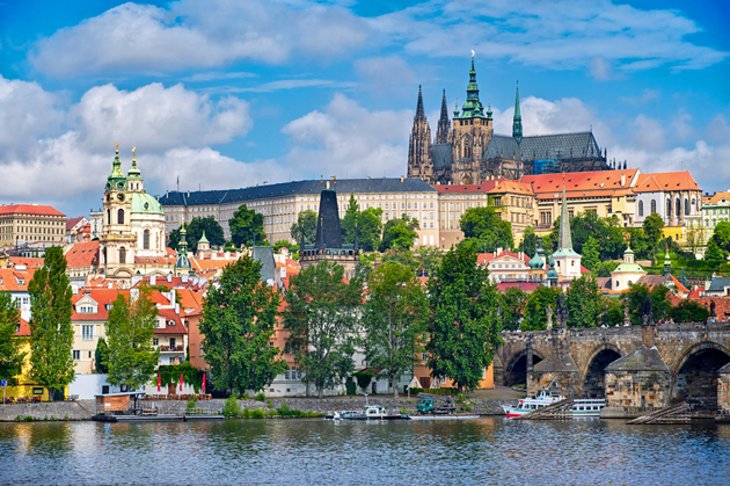
Prague Castle is a castle complex in Prague 1 within Prague, Czech Republic, built in the 9th century. It is the official office of the President of the Czech Republic. The castle was a seat of power for kings of Bohemia, Holy Roman emperors, and presidents of Czechoslovakia. The Bohemian Crown Jewels are kept within a hidden room inside it.
According to the Guinness Book of Records, Prague Castle is the largest ancient castle in the world,occupying an area of almost 70,000 square metres (750,000 square feet), at about 570 metres (1,870 feet) in length and an average of about 130 metres (430 feet) wide. The castle is among the most visited tourist attractions in Prague, attracting over 1.8 million visitors annually.
Located in Prague’s Hradcany neighborhood, Prague Castle (Pražský hrad), once the home of Bohemia’s kings, is today the official residence of the Czech Republic’s President and one of the city’s most visited tourist attractions.
Originally built as a walled fortress around AD 870, the castle has changed dramatically over the years and contains examples of most of the leading architectural styles of the last millennium. Within the castle walls are a number of Prague’s most popular tourist sites, including St. Vitus Cathedral, St. George’s Basilica, the Powder Tower, the Old Royal Palace, and the Golden Lane.
The largest castle complex in the world, this vast fortress requires considerable time to tour, but it’s time well spent (particularly rewarding are the excellent views over the Vltava River with the old town and its many beautiful spires in the background).
2.Stroll across Charles Bridge
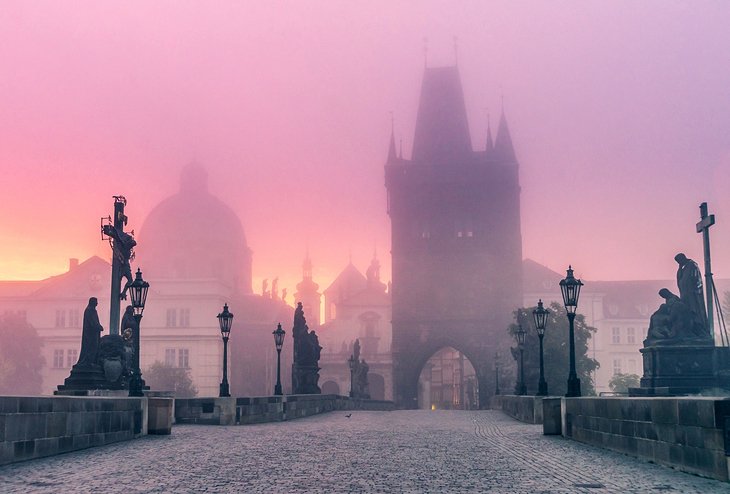
Charles Bridge is a medieval stone arch bridge that crosses the Vltava river in Prague, Czech Republic. Its construction started in 1357 under the auspices of King Charles IV, and finished in the early 15th century.The bridge replaced the old Judith Bridge built 1158–1172 that had been badly damaged by a flood in 1342. This new bridge was originally called Stone Bridge (Kamenný most) or Prague Bridge (Pražský most), but has been referred to as “Charles Bridge” since 1870.
As the only means of crossing the river Vltava until 1841, Charles Bridge was the most important connection between Prague Castle and the city’s Old Town and adjacent areas. This land connection made Prague important as a trade route between Eastern and Western Europe.
The bridge is 516 metres (1,693 ft) long and nearly 10 metres (33 ft) wide. Following the example of the Stone Bridge in Regensburg, it was built as a bow bridge with 16 arches shielded by ice guards. It is protected by three bridge towers, two on the Lesser Quarter side (including the Malá Strana Bridge Tower) and one on the Old Town side, the Old Town Bridge Tower. The bridge is decorated by a continuous alley of 30 statues and statuaries, most of them baroque-style, originally erected around 1700, but now all have been replaced by replicas.
One of the most recognizable old bridges in Europe, magnificent Charles Bridge (Karluv Most) boasts 32 unique points of interest along its 621-meter span. Built in 1357, the bridge has long been the subject of a great deal of superstition, including the builders having laid the initial bridge stone on the 9th of July at exactly 5:31am, a precise set of numbers (135797531) believed to give the structure additional strength. For added good measure, it was constructed in perfect alignment with the tomb of St. Vitus and the setting sun on the equinox.
The bridge is particularly famous for its many fine old statues. Among the most important are those of Holy Roman Emperor Charles IV and John of Nepomuk, the country’s most revered saint, unveiled in 1683 (a more recent superstition involves rubbing the plaque at the base of the statue for the granting of a wish).
3.Discover Wenceslas Square
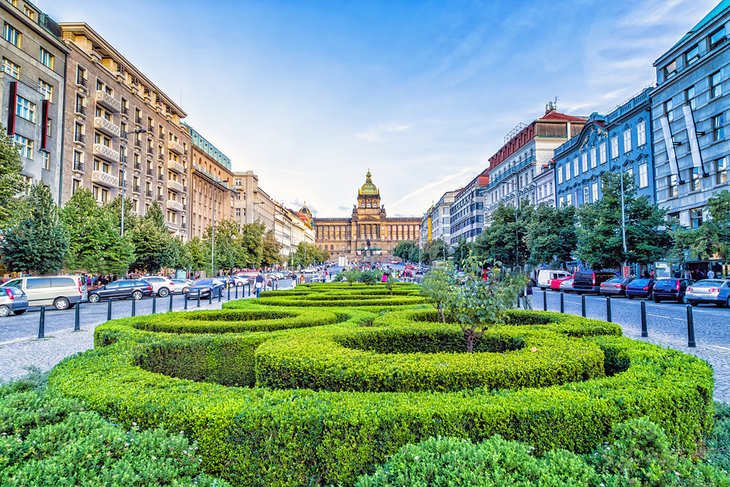
Wenceslas Square colloquially Václavák [ˈvaːtslavaːk]) is one of the main city squares and the centre of the business and cultural communities in the New Town of Prague, Czech Republic. Many historical events occurred there, and it is a traditional setting for demonstrations, celebrations, and other public gatherings. It is also the place with the busiest pedestrian traffic in the whole country. The square is named after Saint Wenceslas, the patron saint of Bohemia. It is part of the historic centre of Prague, a World Heritage Site.
Formerly known as Koňský trh (Horse Market), for its periodic accommodation of horse markets during the Middle Ages, it was renamed Svatováclavské náměstí (English: Saint Wenceslas square) in 1848 on the proposal of Karel Havlíček Borovský.
A highlight of Prague’s New Town (Nové Mesto) district-an area that grew out of the city’s need to expand as it prospered-is the wonderful Wenceslas Square (Václavské námestí), home to the National Museum and numerous other architectural treasures.
Named after the patron saint of Bohemia, whose statue can be seen here, Wenceslas Square was created in the 14th century during the reign of Charles IV as a horse market and has since become one of the city’s most important public spaces, still used for demonstrations and celebrations alike.
4.Explore the Treasures at the National Museum
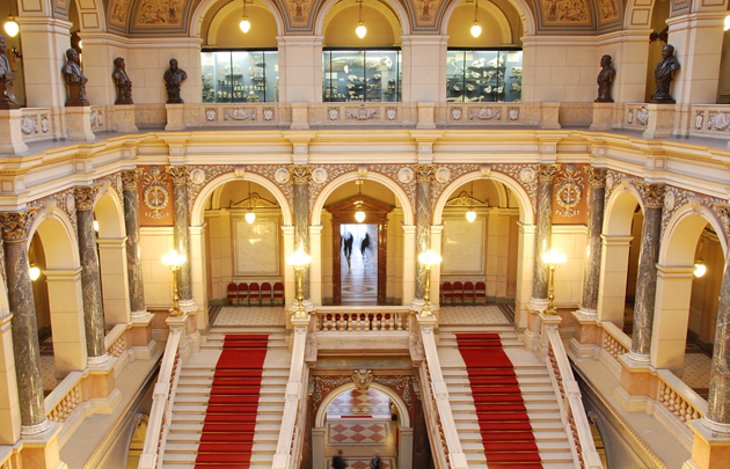
The National Museum muzeum is a Czech museum institution intended to systematically establish, prepare, and publicly exhibit natural scientific and historical collections. It was founded in 1818 by Kašpar Maria Šternberg. Historian František Palackýwas also strongly involved in the foundation of the museum.
The National Museum houses nearly 14 million itemsfrom the areas of natural history, history, arts, music and librarianship, which are located in dozens of museum buildings. The main building of the National Museum has been renovated in 2011–2019, and permanent exhibitions are gradually being opened from Spring 2020.
Fresh from a seven-year-long renovation, the National Museum (Národní Muzeum) in Prague is spread across a number of locations and houses numerous important collections representing a variety of fields, with literally millions of items covering mineralogy, zoology, anthropology, and archaeology, as well as the arts and music. The entomology collection alone numbers more than five million specimens. The oldest museum in the Czech Republic, it was established in the early 1800s before moving to its current location in 1891.
A particularly enjoyable highlight is the archaeology exhibit with its extensive collection of 1st-and 2nd-century Roman artifacts, along with numerous Bronze and Early Iron age finds. (For a comprehensive list of all locations and collections, visit the National Museum’s website, below.)
Another museum to include on your must-visit list is the excellent National Technical Museum (Národní technické museum), which documents the many technological advances the country has contributed to, including displays of machinery and equipment built here over the years, from automobiles to aircraft.
5.St. Vitus Cathedral
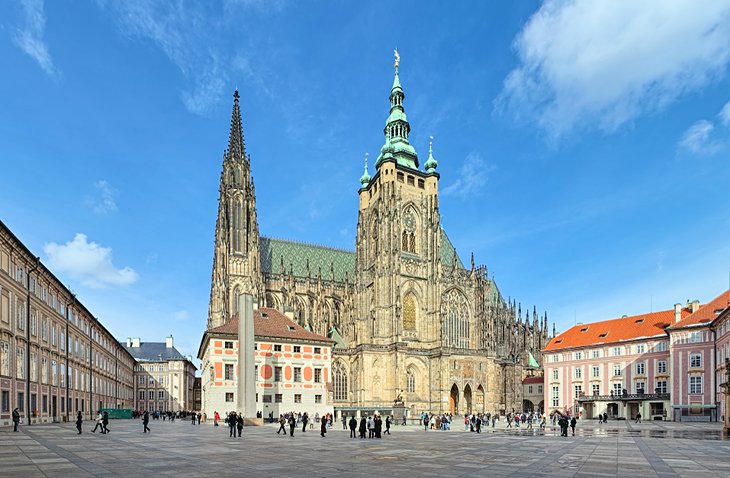
The Metropolitan Cathedral of Saints Vitus, Wenceslaus and Adalbert (Czech: metropolitní katedrála svatého Víta, Václava a Vojtěcha) is a Catholic metropolitan cathedral in Prague, and the seat of the Archbishop of Prague. Until 1997, the cathedral was dedicated only to Saint Vitus, and is still commonly named only as St. Vitus Cathedral (Czech: katedrála svatého Víta).
This cathedral is a prominent example of Gothic architecture, and is the largest and most important church in the country. Located within Prague Castle and containing the tombs of many Bohemian kings and Holy Roman Emperors, the cathedral is under the ownership of the Czech government as part of the Prague Castle complex. Cathedral dimensions are 124 m × 60 m (407 ft × 197 ft), the main tower is 102.8 m (337 ft) high, front towers 82 m (269 ft), arch height 33.2 m (109 ft)
Situated within the grounds of Prague Castle, the Roman Catholic St. Vitus Cathedral (Katedrala St. Vita) is the Czech Republic’s largest and most important Christian church. Seat of the Archbishop of Prague, it’s also home to the tombs of numerous saints and three Bohemian kings.
Founded on the site of a Romanesque rotunda built in AD 925, the cathedral was started in 1344 and took more than 525 years to complete, resulting in a mix of modern Neo-Gothic and 14th-century Gothic styles, along with Baroque and Renaissance influences (be sure to keep an eye out for the impressive gargoyles adorning the exterior of the cathedral).
Interior highlights include stunning stained glass windows depicting the Holy Trinity, a mosaic from 1370 (The Last Judgment), and the St. Wenceslas Chapel (Svatovaclavska kaple) with its spectacular jewel-encrusted altar with more than 1,300 precious stones.
6.Enjoy Free Art at the Municipal House
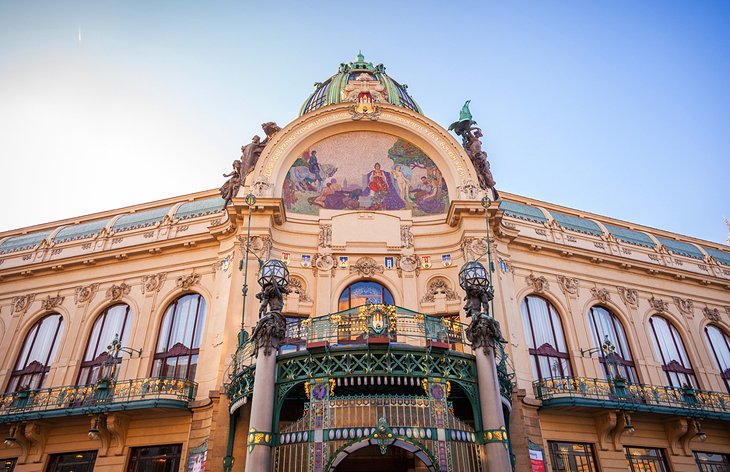
Municipal House (Czech: Obecní dům) is a civic building that houses Smetana Hall, a celebrated concert venue, in Prague, Czech Republic. It is located on Náměstí Republiky next to the Powder Gate in the centre of the city.
The Prague Municipal House (Obecní dum) is widely considered one of the finest examples of Art Nouveau in the city. Built in 1912, this splendid civic building is also home to one of Prague’s most important (and largest) concert venues, Smetana Hall, and boasts numerous striking features, from its sumptuous façade with a large mural on the arch above the second floor balcony, to the large dome that rests behind and above the arch.
The interior is equally impressive and includes many fine stained glass windows and important paintings. While English language guided tours are available (including a chance to see otherwise closed ceremonial rooms), one of the best ways to enjoy this landmark is to take in a concert or sample its café, restaurants, and luxury boutique shops.
The Royal Court palace used to be located on the site of the Municipal House. This complex was built around 1380 by King Wenceslas IV, and from 1383 until 1485, the Kings of Bohemia lived in the property. After 1485, it was abandoned. It was demolished in the early 20th century.
Construction of the current building started in 1905. It was designed by Osvald Polívka and Antonín Balšánek. It opened in 1912.
The Municipal House was the location of the Czechoslovak declaration of independence in 1918.
The roof of the building was the location for the INXS music video for their 1987 hit New Sensation.
7.Spend a Day at the Prague Zoo
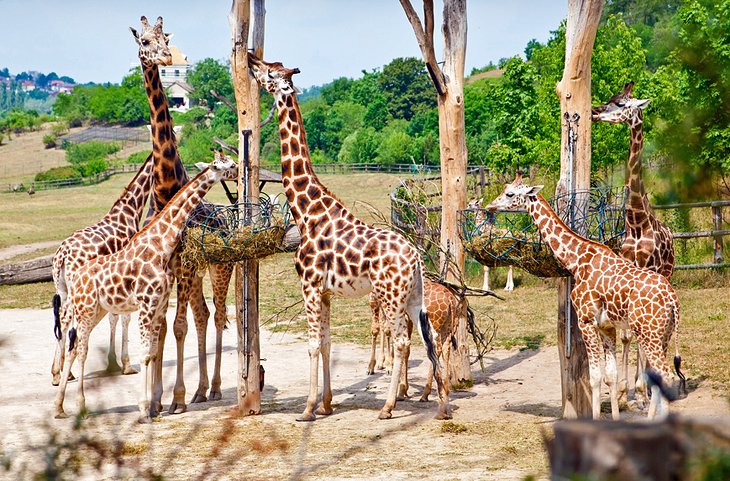
Prague Zoological Garden (Czech: Zoologická zahrada hl. m. Prahy) is a zoo in Prague, Czech Republic. It was opened in 1931 with the goal to “advance the study of zoology, protect wildlife, and educate the public” in the district of Troja in the north of Prague. In 2013, the zoo occupied 58 hectares (140 acres) with 50 hectares (120 acres) in use for exhibits, and housed around 5,000 animals from 676 species, including 132 species listed as threatened.
The zoo is rated as the seventh best zoo in the world by Forbes Travel Guide in 2007,and is rated as the fifth best in the world by TripAdvisor.
The zoo has contributed significantly to saving Przewalski’s horse; for many years, it was the leading breeder of the subspecies. The zoo director is Miroslav Bobek.
Opened in 1931, the superb Prague Zoo (Zoologická zahrada hl. m. Prahy) is not only one of the top tourist attractions in the city, it also ranks among the world’s top zoological parks.
Located in the Troja suburbs just a short distance north of the city center, this 140-acre attraction is an especially fun outing for those traveling with kids. Highlights for younger children include a fun petting zoo, which offers pony rides and opportunities to feed the animals, and a large adventure playground.
Along with its more than 4,200 animals representing some 650 species-including many considered close to extinction-the zoo is notable for its role in saving the native (and endangered) Przewalski’s horse.









